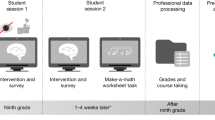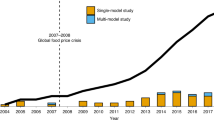Abstract
Background/objectives:
This paper reports on the evaluation of the Smart Choices healthy food and drink supply strategy for Queensland schools (Smart Choices) implementation across the whole school environment in state government primary and secondary schools in Queensland, Australia.
Subjects/methods:
Three concurrent surveys using different methods for each group of stakeholders that targeted all 1275 school Principals, all 1258 Parent and Citizens’ Associations (P&Cs) and a random sample of 526 tuckshop convenors throughout Queensland. Nine hundred and seventy-three Principals, 598 P&Cs and 513 tuckshop convenors participated with response rates of 78%, 48% and 98%, respectively.
Results:
Nearly all Principals (97%), P&Cs (99%) and tuckshop convenors (97%) reported that their school tuckshop had implemented Smart Choices. The majority of Principals and P&Cs reported implementation, respectively, in: school breakfast programs (98 and 92%); vending machine stock (94 and 83%); vending machine advertising (85 and 84%); school events (87 and 88%); school sporting events (81 and 80%); sponsorship and advertising (93 and 84%); fundraising events (80 and 84%); and sporting clubs (73 and 75%). Implementation in curriculum activities, classroom rewards and class parties was reported, respectively, by 97%, 86% and 75% of Principals. Respondents also reported very high levels of understanding of Smart Choices and engagement of the school community.
Conclusions:
The results demonstrated that food supply interventions to promote nutrition across all domains of the school environment can be implemented successfully.
This is a preview of subscription content, access via your institution
Access options
Subscribe to this journal
Receive 12 print issues and online access
$259.00 per year
only $21.58 per issue
Buy this article
- Purchase on Springer Link
- Instant access to full article PDF
Prices may be subject to local taxes which are calculated during checkout

Similar content being viewed by others
References
Queensland Government. Eat Well Be Active - Healthy Kids for Life. Queensland Health: Brisbane, QLD, 2005 (cited 8 May 2012); Available from http://www.health.qld.gov.au/ph/documents/hpu/29187.pdf.
Bellisle F . Effects of diet on behaviour and cognition in children. Br J Nutr 2004; 92 (Suppl 2), S227–S232.
Taras H . Nutrition and student performance at school. J Sch Health 2005; 75: 199–213.
Abbott R, Macdonald D, Stubbs C, Lee A, Harper C, Davies P . Healthy Kids Queensland Survey 2006: Full Report. Queensland Health: Brisbane, QLD, 2008 (cited 8 May 2012); Available from http://www.health.qld.gov.au/ph/documents/hpu/healthykidsqld2006.pdf.
Lobstein T, Baur L, Uauy R . Obesity in children and young people: a crisis in public health. Obes Rev 2004; 5 (Suppl 1), 4–104.
Perez-Rodrigo C, Klepp KI, Yngve A, Sjostrom M, Stockley L, Aranceta J . The school setting: an opportunity for the implementation of dietary guidelines. Public Health Nutr 2001; 4: 717–724.
Bell AC, Swinburn BA . What are the key food groups to target for preventing obesity and improving nutrition in schools? Eur J Clin Nutr 2004; 58: 258–263.
Sanigorski AM, Bell AC, Kremer PJ, Swinburn BA . Lunchbox contents of Australian school children: room for improvement. Eur J Clin Nutr 2005; 59: 1310–1316.
Bell AC, Swinburn BA . School canteens: using ripples to create a wave of healthy eating. Med J Aust 2005; 183: 5–6.
Cleland V, Worsley A, Crawford D . What are grade 6 and 6 children buying from school canteens and what do parents and teachers think about it? Nutr Diet 2004; 61: 145–150.
Subratty AH, Chan Sun M, Kassean HK . A need for healthy canteens in secondary schools in mauritius. Nutr Food Sci 2003; 33: 208–212.
Moore L, Tapper K . The impact of school fruit tuck shops and school food policies on children’s fruit consumption: a cluster randomised trial of schools in deprived areas. J Epidemiol Community Health 2008; 62: 926–931.
Waters E, de Silva-Sanigorski A, Hall BJ, Brown T, Campbell KJ, Gao Y et al. Interventions for preventing obesity in children. Cochrane Database Syst Rev 2011 CD001871.
Office of Economic and Statistical Research. Information Brief Schools Australia 2007: OESR: Brisbane, 2008.
Queensland Council of Parents and Citizens’ Associations Inc. Operations Manual 2011. manual for P&C Associations. QCPCA: Brisbane, 2011, Available from http://www.qcpca.org.au/publications/manuals/pc-operations-manual.
Queensland Government. Smart Choices: Healthy Food and Drink Supply Strategy for Queensland Schools. Department of Education, Training and the Arts: Brisbane, QLD, 2005 (cited 3 October 2011); Available from http://education.qld.gov.au/schools/healthy/food-drink-resources.html.
National Health and Medical Research Council. Dietary Guidelines for Children and Adolescents in Australia. NHMRC: Canberra, 2003.
Briggs M, Safaii S, Beall DL . Position of the American Dietetic Association, Society for Nutrition Education, and American School Food Service Association--Nutrition services: an essential component of comprehensive school health programs. J Am Diet Assoc 2003; 103: 505–514.
Perez-Rodrigo C, Aranceta J . Nutrition education in schools: experiences and challenges. Eur J Clin Nutr 2003; 57 (Suppl 1), S82–S85.
Warren JM, Henry CJ, Lightowler HJ, Bradshaw SM, Perwaiz S . Evaluation of a pilot school programme aimed at the prevention of obesity in children. Health Promot Int 2003; 18: 287–296.
New South Wales Health. Fresh Tastes@School: NSW Healthy School Canteen Strategy. NSW Health: North Sydney, NSW, 2004 (cited 3 October 2011); Available from http://www.health.nsw.gov.au/resources/publichealth/healthpromotion/obesity/pdf/can_menuplan.pdf.
Kafatos A, Manios Y, Moschandreas J . Health and nutrition education in primary schools of Crete: follow-up changes in body mass index and overweight status. Eur J Clin Nutr 2005; 59: 1090–1092.
Powers AR, Struempler BJ, Guarino A, Parmer SM . Effects of a nutrition education program on the dietary behavior and nutrition knowledge of second-grade and third-grade students. J Sch Health 2005; 75: 129–133.
Cullen KW, Hartstein J, Reynolds KD, Vu M, Resnicow K, Greene N et al. Improving the school food environment: results from a pilot study in middle schools. J Am Diet Assoc 2007; 107: 484–489.
Cullen KW, Watson K, Zakeri I . Improvements in middle school student dietary intake after implementation of the Texas Public School Nutrition Policy. Am J Public Health 2008; 98: 111–117.
Cullen KW, Watson KB . The impact of the Texas public school nutrition policy on student food selection and sales in Texas. Am J Public Health 2009; 99: 706–712.
Matthews A, Nelson M, Kaur A, Rayner M, Kelly P, Cowburn G . Where has all the chocolate gone? A national survey assesses the effects of recent legislation to improve the nutritional quality of English secondary-school vending. Public Health Nutr 2011; 14: 1394–1402.
Powell CA, Walker SP, Chang SM, Grantham-McGregor SM . Nutrition and education: a randomized trial of the effects of breakfast in rural primary school children. Am J Clin Nutr 1998; 68: 873–879.
Shemilt I, Harvey I, Shepstone L, Swift L, Reading R, Mugford M et al. A national evaluation of school breakfast clubs: evidence from a cluster randomized controlled trial and an observational analysis. Child Care Health Dev 2004; 30: 413–427.
Ozer EJ . The effects of school gardens on students and schools: conceptualization and considerations for maximizing healthy development. Health Edu Behav 2007; 34: 846–863.
de Sa J, Lock K . Will European agricultural policy for school fruit and vegetables improve public health? A review of school fruit and vegetable programmes. Eur J Public Health 2008; 18: 558–568.
Laurence S, Peterken R, Burns C . Fresh Kids: the efficacy of a Health Promoting Schools approach to increasing consumption of fruit and water in Australia. Health Promot Int 2007; 22: 218–226.
French SA, Story M, Fulkerson JA, Hannan P . An environmental intervention to promote lower-fat food choices in secondary schools: outcomes of the TACOS Study. Am J Public Health 2004; 94: 1507–1512.
Cullen KW, Watson K, Zakeri I, Ralston K . Exploring changes in middle-school student lunch consumption after local school food service policy modifications. Public Health Nutr 2006; 9: 814–820.
Contento IR, Randell JS, Basch CE . Review and Analysis of Evaluation Measures Used in Nutrition Education Intervention Research. J Nutr Edu Behav 2002; 34: 2–25.
de Silva-Sanigorski A, Breheny T, Jones L, Lacy K, Kremer P, Carpenter L et al. Government food service policies and guidelines do not create healthy school canteens. Aust N Z J Public Health 2011; 35: 117–121.
Perry CL, Bishop DB, Taylor GL, Davis M, Story M, Gray C et al. A randomized school trial of environmental strategies to encourage fruit and vegetable consumption among children. Health Edu Behav 2004; 31: 65–76.
Masse LC, Frosh MM, Chriqui JF, Yaroch AL, Agurs-Collins T, Blanck HM et al. Development of a School Nutrition-Environment State Policy Classification System (SNESPCS). Am J Prev Med 2007; 33 (4 Suppl), S277–S291.
Pettigrew S, Donovan RJ, Jalleh G, Pescud M, Cowie S Addressing Childhood Obesity Through School Canteens. University of Western Australia Business School and Centre for Behavioural Research in Cancer Control, Curtin University: Perth, WA, 2009 (cited 3 October 2011); Available from http://www.det.wa.edu.au/healthyfoodanddrink/detcms/navigation/resources/?oid=Category-id-11227876.
Story M, Nanney MS, Schwartz MB . Schools and obesity prevention: creating school environments and policies to promote healthy eating and physical activity. Milbank Q 2009; 87: 71–100.
Wharton CM, Long M, Schwartz MB . Changing nutrition standards in schools: the emerging impact on school revenue. J Sch Health 2008; 78: 245–251.
Queensland Association of School Tuckshops. Fresh Ideas for Fundraising. The Association: Brisbane, QLD, 2006 (cited 4 May 2012); Available from http://www.qast.org.au/FreshIdeasforFundraising/tabid/89/Default.aspx.
Harrison MS, Coyne T, Lee AJ, Leonard D, Lowson S, Groos A et al. The increasing cost of the basic foods required to promote health in Queensland. Med J Aust 2007; 186: 9–14.
Queensland Association of School Tuckshops. Tuckshop Snapshot 2008. The Association: Brisbane, QLD, 2008 (cited 4 May 2012); Available from http://www.qast.org.au/Portals/0/PDFS/MBF%20summary.pdf.
Australian Bureau of Statistics. Australian Social Trends. Chapter 4, Volunteers ABS: Canberra, 2008 [cited 3 October 2011]; Available from http://www.abs.gov.au/AUSSTATS/abs@.nsf/Lookup/4102.0Chapter4102008.
Sutherland R, Gill T, Binns C . Do parents, teachers, and health professionals support school-based obesity prevention? Nutr Diet 2004; 61: 137–144.
Hagar MA, Wilson S, Pollack TH, Rooney PM . Response Rates for Mail Surveys of Non-profit Organisations: a review and empirical test. Nonprofit Volunt Sector Q 2003; 32: 252–267.
Kaplowitz MD, Hadlock TD, Levine R . A comparison of web and mail survey response rates. Public Opin Q 2004; 1: 94–101.
Cho H, Nadow MZ . Understanding barriers to implementing quality lunch and nutrition education. J Community Health 2004; 29: 421–435.
Author information
Authors and Affiliations
Corresponding author
Ethics declarations
Competing interests
The authors declare no conflict of interest.
Rights and permissions
About this article
Cite this article
Dick, M., Lee, A., Bright, M. et al. Evaluation of implementation of a healthy food and drink supply strategy throughout the whole school environment in Queensland state schools, Australia. Eur J Clin Nutr 66, 1124–1129 (2012). https://doi.org/10.1038/ejcn.2012.108
Received:
Revised:
Accepted:
Published:
Issue Date:
DOI: https://doi.org/10.1038/ejcn.2012.108



